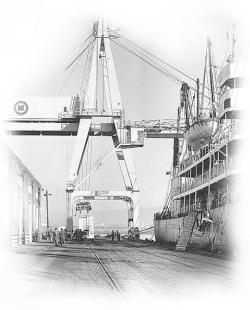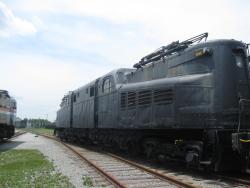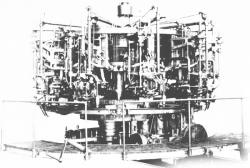The quantities of materials used in the building are staggering: 12,000 tons of structural steel; 42,000 cubic yards of concrete - consisting of 65,000 barrels of cement and 25,000 tons of sand; 360,000 feet of piling; and 10,000,000 bricks. At the time of its construction, Atlantic City Municipal Convention Hall was believed to be the world's largest hall, capable of seating 40,000 people. It continues to serve as a meeting place for shows, pageants, sporting events, and conventions. It is a structure of heroic proportions.
1983


This hydraulic closed-die press, among the largest fabrication tools in the world, has had a profound influence in America's leading role in commercial aircraft, military aircraft, and space technology. As part of the same Heavy Press Program that created the Mesta press, the Wyman-Gordon press was designed by the Loewy Construction Company and began operating in October 1955. Among its contributions was the development of the new jetliner Boeing 747 in the 1960s.

The world's first high-speed, dockside container-handling cranes reduced ship turnaround time from three weeks to eighteen hours. They became the model and set the standard for future designs worldwide. In service January 7, 1959, the A-frame cranes built at Encinal Terminals in Alameda, California, were designed to move large quantities of products with less handling, less damage, and less pilferage. Under the leadership of C. Dean Ramsden, P.E., the Pacific Coast Engineering Company (PACECO Inc.) met performance specifications developed by the Matson Navigation Company.

The 4,620-horsepower GG1 was primarily a passenger locomotive, routinely operating at over 100 miles per hour, but was used in freight service as well. Conceived by the Pennsylvania Railroad and built by the Baldwin Locomotive Works and General Electric Company, No. 4800 logged nearly 5 million miles in its forty-five-year life. It was the prototype for a 139-unit fleet built during a decade to serve on the PRR's electrified lines, and the only one with a riveted body shell; the remainder were welded.

Only since 1912 have glass jars and bottles been in cheap and plentiful supply for pharmaceuticals, household products, food and beverages, and an endless variety of uses. The bottle-making machine introduced the safety, standardization, quality, and convenience of glass containers. Not only did they revolutionize the industry, the Owens machines ended child labor in glass-container plants. In 1913, the National Child Labor Committee of New York City said the rapid introduction of the automatic machine did more to eliminate child labor than they had been able to do through legislation.


